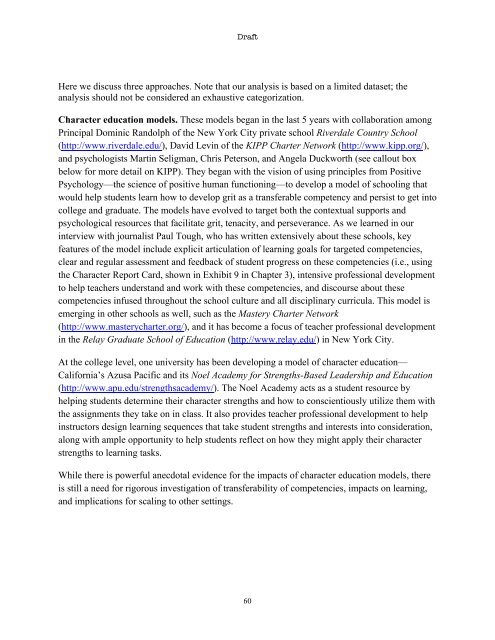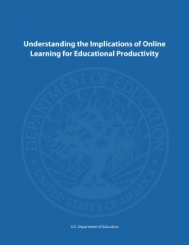Promoting Grit, Tenacity, and Perseverance - U.S. Department of ...
Promoting Grit, Tenacity, and Perseverance - U.S. Department of ...
Promoting Grit, Tenacity, and Perseverance - U.S. Department of ...
You also want an ePaper? Increase the reach of your titles
YUMPU automatically turns print PDFs into web optimized ePapers that Google loves.
Draft<br />
Here we discuss three approaches. Note that our analysis is based on a limited dataset; the<br />
analysis should not be considered an exhaustive categorization.<br />
Character education models. These models began in the last 5 years with collaboration among<br />
Principal Dominic R<strong>and</strong>olph <strong>of</strong> the New York City private school Riverdale Country School<br />
(http://www.riverdale.edu/), David Levin <strong>of</strong> the KIPP Charter Network (http://www.kipp.org/),<br />
<strong>and</strong> psychologists Martin Seligman, Chris Peterson, <strong>and</strong> Angela Duckworth (see callout box<br />
below for more detail on KIPP). They began with the vision <strong>of</strong> using principles from Positive<br />
Psychology—the science <strong>of</strong> positive human functioning—to develop a model <strong>of</strong> schooling that<br />
would help students learn how to develop grit as a transferable competency <strong>and</strong> persist to get into<br />
college <strong>and</strong> graduate. The models have evolved to target both the contextual supports <strong>and</strong><br />
psychological resources that facilitate grit, tenacity, <strong>and</strong> perseverance. As we learned in our<br />
interview with journalist Paul Tough, who has written extensively about these schools, key<br />
features <strong>of</strong> the model include explicit articulation <strong>of</strong> learning goals for targeted competencies,<br />
clear <strong>and</strong> regular assessment <strong>and</strong> feedback <strong>of</strong> student progress on these competencies (i.e., using<br />
the Character Report Card, shown in Exhibit 9 in Chapter 3), intensive pr<strong>of</strong>essional development<br />
to help teachers underst<strong>and</strong> <strong>and</strong> work with these competencies, <strong>and</strong> discourse about these<br />
competencies infused throughout the school culture <strong>and</strong> all disciplinary curricula. This model is<br />
emerging in other schools as well, such as the Mastery Charter Network<br />
(http://www.masterycharter.org/), <strong>and</strong> it has become a focus <strong>of</strong> teacher pr<strong>of</strong>essional development<br />
in the Relay Graduate School <strong>of</strong> Education (http://www.relay.edu/) in New York City.<br />
At the college level, one university has been developing a model <strong>of</strong> character education—<br />
California’s Azusa Pacific <strong>and</strong> its Noel Academy for Strengths-Based Leadership <strong>and</strong> Education<br />
(http://www.apu.edu/strengthsacademy/). The Noel Academy acts as a student resource by<br />
helping students determine their character strengths <strong>and</strong> how to conscientiously utilize them with<br />
the assignments they take on in class. It also provides teacher pr<strong>of</strong>essional development to help<br />
instructors design learning sequences that take student strengths <strong>and</strong> interests into consideration,<br />
along with ample opportunity to help students reflect on how they might apply their character<br />
strengths to learning tasks.<br />
While there is powerful anecdotal evidence for the impacts <strong>of</strong> character education models, there<br />
is still a need for rigorous investigation <strong>of</strong> transferability <strong>of</strong> competencies, impacts on learning,<br />
<strong>and</strong> implications for scaling to other settings.<br />
60
















